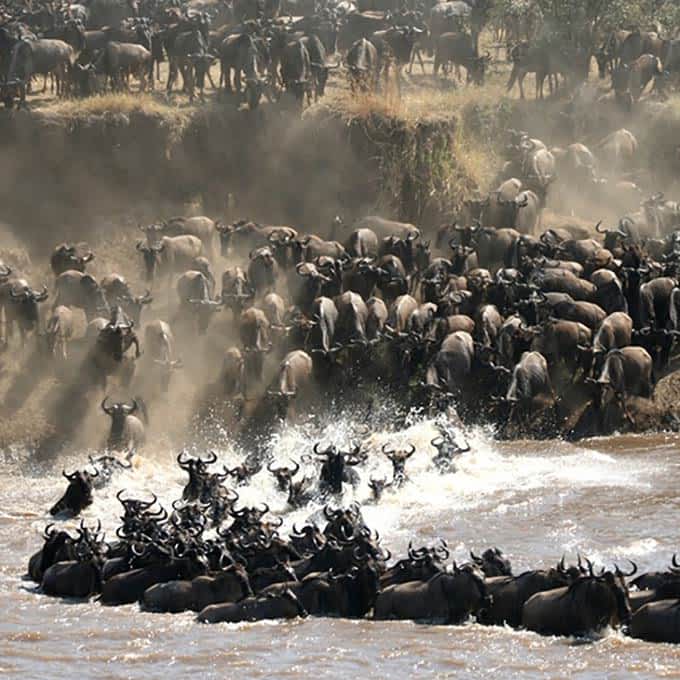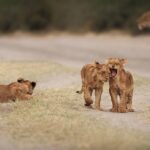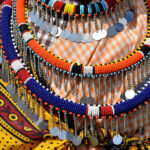
The Great Migration is one of the most awe-inspiring wildlife spectacles on Earth. Every year, over 1.5 million wildebeest, accompanied by hundreds of thousands of zebras and gazelles, embark on a treacherous journey through the Serengeti-Mara ecosystem in search of greener pastures. For travelers, witnessing this epic event is a once-in-a-lifetime experience. But to catch the migration at its peak, timing is everything.
Understanding the Great Migration
The Great Migration is a year-round event, but the animals’ movements follow a somewhat predictable pattern, dictated by the rains and the availability of fresh grazing. Here’s a breakdown of the migration’s phases and where you need to be to witness each one:
- Calving Season (January to March)
- Location: Southern Serengeti, Ndutu Plains, and Ngorongoro Conservation Area.
- What to Expect: The migration begins in the southern Serengeti, where the wildebeest give birth to around 500,000 calves over a few weeks. This is a time of abundance, with lush grasses providing ample food. It’s also a time of danger, as predators like lions, cheetahs, and hyenas take advantage of the vulnerable newborns.
- The Long Journey North (April to June)
- Location: Central Serengeti, Moru Kopjes, and Western Corridor.
- What to Expect: As the rains end, the herds begin moving north towards the central Serengeti. April and May are known for the dramatic scenes of wildebeest and zebras traversing the plains. By June, the herds reach the Western Corridor and Grumeti River, where crocodiles lie in wait for the crossing.
- Grumeti and Mara River Crossings (July to September)
- Location: Northern Serengeti and Maasai Mara (Kenya).
- What to Expect: The most famous and dramatic phase of the migration is the river crossings. In July, the herds gather at the Grumeti River, where they face the perilous crossing. By August, they’ve reached the Mara River, the most treacherous point of the journey. Here, the frantic scramble across the river, with crocodiles snapping at their heels, is an unforgettable sight.
- Life in the Mara (October to November)
- Location: Maasai Mara (Kenya) and Northern Serengeti.
- What to Expect: After the harrowing river crossings, the herds spread out across the Maasai Mara and the northern Serengeti, grazing on the rich pastures. This is a great time for game viewing, as the animals are more dispersed and relaxed, making for excellent photography opportunities.
- Return to the Serengeti (December)
- Location: Southern Serengeti.
- What to Expect: As the short rains begin in November, the herds start their journey back to the southern Serengeti. By December, they have returned to the Ndutu Plains, where the cycle begins again.
Best Time to Visit the Serengeti
To determine the best time to visit the Serengeti for the Great Migration, consider what part of the migration you most want to witness:
- Calving Season (January to March): This is the best time to see newborns and predator action. The landscape is lush, and the weather is generally warm, making it a fantastic time for photography.
- River Crossings (July to September): If you want to witness the dramatic river crossings, plan your visit between July and September. This period offers heart-pounding action as the herds face the crocodile-infested rivers.
- Late Migration (October to November): For those who prefer a less crowded experience with excellent game viewing, October and November are ideal. The herds are still in the northern Serengeti, and the weather is more temperate.
Where to Stay During the Great Migration
Choosing the right accommodation is crucial for getting close to the action. African Odyssey Explorer offers a range of luxury lodges and mobile camps strategically located to follow the migration:
- Southern Serengeti: Stay in Ndutu for the calving season, with luxury tented camps offering intimate access to the wildlife.
- Central Serengeti: Choose a central Serengeti lodge in April to June to witness the herds’ movement and predator interactions.
- Northern Serengeti: Opt for a mobile camp near the Mara River between July and September to be right at the heart of the river crossings.
Why Book with African Odyssey Explorer?
At African Odyssey Explorer, we specialize in tailor-made safari experiences. Our expert guides know the Serengeti like the back of their hand, ensuring you’re in the right place at the right time to witness the Great Migration in all its glory. From luxury accommodations to private game drives, we handle every detail to make your African adventure unforgettable.
Don’t miss the greatest wildlife show on Earth. Contact African Odyssey Explorer today to book your Serengeti safari during the Great Migration!





